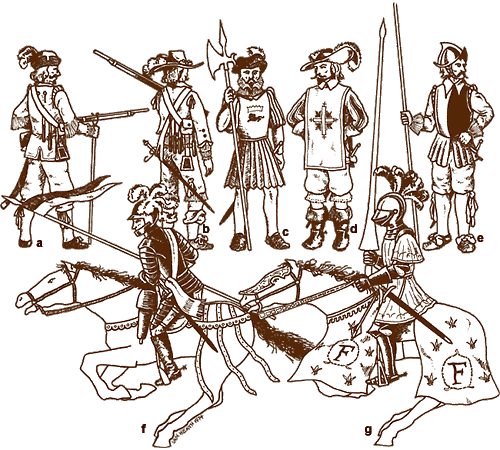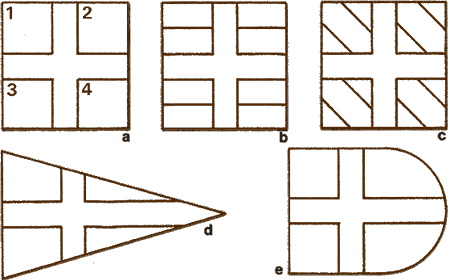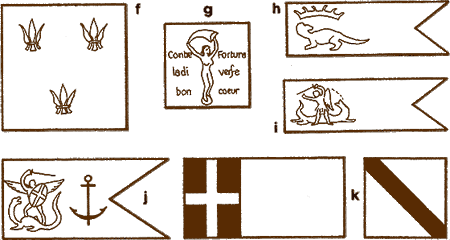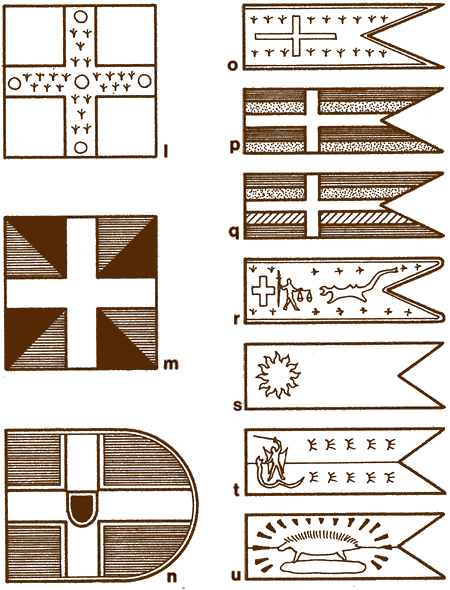
 |
|
|
Renaissance Armies: The French
An article by George Gush The Italian Wars Cavalry
The Ban and Arriere-Ban, strictly feudal cavalry, were used mainly in time of emergency (up to the early 17th Century), while the main strength of the Gendarmerie were the Compagnies d'Ordonnance, paid and semi-regular, though still gentry. They originally comprised 15 Compagnies each of 100 "lances". A lance contained, beside a Gendarme, two archers (really heavy cavalrymen, later referred to as Chevaux-legers, with at least half-armour, mail sleeves, light lance, and unarmoured horse, they may still have had a bow for dismounted use in the 1490s, later carried a pistol), a coutillier (who finished-off an enemy unhorsed!) valet, and page. Of these only the archers were combatants, possibly originally supporting the gendarmes in second and third rank, later usually formed on their own. Their proportion compared with the Gendarmerie was reduced to 3:2 in 1534 and probably later to 1:1. Gendarme companies fell to a usual strength of 50 by the mid-16th Century, but tactical units usually seem to have been about 400 strong. Additional gendarmes were provided by the Royal Guard (usually 100 Scots, 100 French, with 400 Archers, 100 of them Scots too) and by the companies of princes or great nobles, often over-strength. In the Italian Wars, Italian gendarmes and mounted crossbowmen or later arquebusiers, fought alongside the French, who also hired some thousands of Stradiots and introduced "Argoulets" in imitation of them: wearing cabacete morion, light cuirasse and mail sleeves, they were armed with crossbow—later arquebus—mace and sword. From 1529, arquebusiers a cheval were attached to support the Gendarme companies. In the earlier Italian wars—and the Wars of Religion—one third or more of a French army could be cavalry.  a. and b. French musketeers circa 1640; note short saber carried by 'a', c. Scots Guard archer of Francis I's reign showing the type of dress and armament used on dismounted guard duty at court, d. French musketeer, mid-17th Century. Hat gray or black with gilt trim and red plumes. Tabard or casaque blue, cross and edge white, "flames" in angles of cross red for Gray Musketeers, yellow for Black. Jacket and breeches blue, trimmed gold. Boots black with red heels. Sword probably slung from embroidered shoulder belt. Cuirass under casaque. e. French pikeman circa 1640; note extremely large garters and shoe bosses, f. Guard Chevauleger, early 17th Century. Armour and horse trappings black. Sash white and gold, pennon black and white, plumes white (a 17th Century gendarme would be similar except for the lance); armour to knees. Note pistol holsters at front of saddle, g. French Gendarme of late 15th or early 16th Century. Horse bard is that of Francis I—probably blue and gold. The rider could wear only the "skirt" of his coat, leaving the rest of his armour (torso and arms) fully exposed. Infantry The native French infantry, in contrast to the cavalry, were considered unfit to take the brunt of the infantry battle. In the 15th Century a militia of 16,000 "Francs-Archers" had been set up, and some thousands of these were employed in the earlier Italian Wars period, but proved highly unreliable, being abolished in 1535. They were variously armed and probably still included some long-bowmen at the end of the 15th Century. The greater part of the French infantry however, were mercenary bands of "aventuriers", some of them, like the "Vielles Bandes de Piedmont" so constantly employed as to become virtually regulars. Gascons, who were considered (particularly in their own eyes) the best soldiers in France, predominated. The chief weapon of the infantry was the crossbow, not replaced by the arquebus until the 1520s, but there were also pikemen, for the French foot in the early Italian Wars emulated the tactics of the Swiss (who were called in to train them at times) "with the same discipline and method, though not with the same courage". Infantry bands or "ensigns" were 500 strong for Francs-Archers, otherwise 230-300 men. Fifty percent or more of the infantry of French armies, however, was normally mercenary; predominantly Swiss (exclusively in French service after 1516), otherwise Lansknechts, both at this period around 65 percent pike-men, 25 percent halberdiers and the like, ten percent arquebusiers. There were also Italians, mainly skirmishers. A new attempt at a French national infantry was made in 1531, when Francis I founded the 6,000 man "legions" of Normandy, Languedoc, Champagne and Picardy. As with the Compagnies d'Ordonnance, only a cadre was permanently embodied, the rest mustering only occasionally in peace. Composition varied but was around 60 percent pikemen, in burgonet, corselet and tassets, ten percent halberdiers and 30 percent shot, in morions. Though of dubious value, they were maintained or revived until the wars of religion, two or three more being added. Bands of around 1,000 were sometimes detached for separate service. Artillery The French guns made perhaps the greatest impression in Italy; Charles VIII's 36 bronze horse-drawn pieces were the first effective field artillery. By 1536 the French artillery train of some 40 pieces had over 100 gunners, conductors and craftsmen, 800 pioneers, 680 horses and a picked escort of four ensigns of foot. Guns were generally heavy—in the 1550s cannon, culverins or culverin bastard-calibres being standardized. The Wars of Religion Catholics For much of the period, the royal side so inherited most of the existing army. Their cavalry centered on the gendarmerie using their old tactics, though with unarmoured horses, supplemented by German reiters (heavy cavalry with pistols using "caracole" tactics based on firepower), and similar French pistoliers and mounted arquebusiers, now referred to as "carabins". They had the legions (except Languedoc, which mostly deserted to the Huguenots) and the much better "Vielles Bandes" of mercenaries; from these were developing the regimental organization which gave France her first permanent regular infantry units; by the later wars being of ten to 12 companies, and around 1,000 strong, but still often grouped on the battlefield in large "battalions" of up to 5,000. They also had the Swiss, hired Lansknechts in large numbers, and were lent Spanish infantry. Their armies, especially the cavalry raised by nobles, were very showily dressed, with plumes, gilt armour, velvet and gold embroidered mandelions and so on.
The cavalry were dependent upon the "squirearchy" of the Protestant areas, who produced a brave and Ironside-like horse, distinguished by the long-sleeved white casaques they wore over their armour in old fashioned style (their opponents nicknamed them "Millers"). They were mostly half-armoured, and armed with sword and pistols, and though originally formed en haye were taught under Henry of Navarre to form in squadrons six or seven ranks deep, charging home with the sword and using their pistols in the ensuing melee, highly-effective tactics. Again reiters were hired; some of them adopting the new tactics, and most of the lighter cavalry were arquebus-armed. Huguenot infantry, especially at the outset, were somewhat improvised, and even when their discipline improved, almost totally lacked pikes, being at first all arquebusiers, by the end of the wars nearly all musketeers. By 1587 they were taught to fire regular volleys, two ranks at a time, the front kneeling. They also had regimental organization, but seem to have often operated in smaller tactical groups, sometimes interspersed with cavalry. They were supplemented by smallish numbers of Lansknechts, some not-very-effective English and Scots, and at the end of the wars by the Royal Swiss. 17th Century Armies Henry IV (Navarre) established the regular army in 1597 from both Catholic and Protestant troops. The French regiments, starting with "Les Vieux"—Picardy, Champagne and Navarre, and the Garde Francais, were made permanent, and new regiments such as Piedmont, Normandy and Lorraine added; 1,200 strong, one-third muskets, two-thirds pikes. By 1609 there were 20,000 French infantry, and 12,000 foreign, mainly Swiss. The basis of the cavalry were 4,000 regular Gendarmes, now half-armoured pistoliers, supported by sections of "Carabins", and there was a 1,000 strong "Cornette Blanche" of noble volunteers, a company of 200 Guard Chevaulegers, and a unit of gentlemen, the "Carabiniers du Roy" who in 1622 became the famous company of Gray Musketeers (a company of Black Musketeers was added in 1661—despite their name both were heavy cavalry, the colors being those of their horses). Under Richelieu, in the 1640s, the army was further overhauled and expanded, partly by the takeover of an army of 8,000 ex-Swedish troops previously led by Bernard of Saxe-Weimar (foreigners were reckoned worth three men—one more for France, one less for the enemy, and one Frenchman released for productive work!). Infantry began to operate in small battalions of 600 to 800, usually formed six deep, pikes (now perhaps as few as one third) in the center (regiments could form half, one or two battalions). Cavalry companies and cornets began to be grouped in regiments, but fought in "squadrons" of about 200. By 1660 there were 109 infantry regiments (30 foreign, mainly Scots and Swiss) and 30 cavalry regiments. Most cavalry were three-quarter or half-armoured pistoliers; there was at least one buff-coated dragoon regiment, and there were some irregular light cavalry or "Croats". The French did not adopt uniform until well into the later 17th Century, though some companies and perhaps regiments had distinctive coat colors; light gray was common, but red and blue were also worn (the latter by the Gardes Francaises). 17th Century French seem to have been distinguished by an addiction to frills, bows, ribbons and plumes, suitable to the future leaders of European fashion. In the Guards, the Scots archers in 1494 wore red, white and green striped sleeveless jacket with white and yellow collar, later usually white, trimmed with silver. Guard Gendarmes probably had red coats. Many Guard troops would wear the Royal badge on back and breast—for example: Louis XII-acrowned porcupine; Francis I—a crowned salamander; Henry II—acrowned 'H' with a silver crescent below; and Henry IV- a club of Hercules, wrapped in a streamer bearing his motto Haec Quoque Cognita Monstra. National signs were, in the 16th Century, a white cross on back and breast, in the 17th Century a white sash. For information on the Swiss Guard, see Renaissance Armies: The Swiss. Flags As shown, the French flags of the 15th and early 16th Centuries were predominantly red with a white cross, though blue and striped backgrounds were also used; the rounded form shown appears to have been commonest in the Italian Wars period. From this was derived the standard form of French infantry flag in the 17th Century (and later), consisting of a large square standard with white cross and varying backgrounds. For the original French regiments, the background colors were: Gardes Francaises—blue; Picardy—scarlet; Piedmont—black; Champagne—green (at least in the 18th Century, this was the only regiment with a diagonal white cross); and Navarre—russet (originally Henry IV's Guards). French Colonels had sometimes been allotted a white standard as a mark of their rank, as early as Henry II's reign. The Huguenots made much use of white flags during the Wars of Religion, and in the early 17th Century, a white Colonel's color was allotted to each permanent regiment as a sign of its status. 12 were carried in 1616, 21 by 1635 (the year when battalions were introduced). The French thus probably set the fashion, widespread by the mid-17th Century, of a white colonel's color. They also fixed the quota of flags for each battalion at three, and a three-flag-to-a-battalion ratio also became popular later in the 17th Century. It is supposed to have been derived from the Swedes, but they in fact carried company flags till well after Gustavus Adolphus' time, and pictures of French units after 1635 also sometime show more than three flags, so it would appear that it was a rule not always kept. The other "standard" devices on French standards were St. Michael (usually shown as a winged, armoured figure slaying a dragon) and the sun (surrounded by varying numbers of pointed rays and displaying a smiling face). These were particularly used on cavalry standards and by Guards units. Thus, Charles VIII's Scots guards had a red, green and white flag with both devices in gold, the sun's rays covering the whole field; some of Louis XII's guards had a red and yellow flag with the saint (the field charged with porcupines, the King's badge). Other Guards flags varied, however: Henry II's Guards had white flags with a silver crescent and the motto Donee Totum Corn-pleat Orbum, and under Louis XIII the Scots company of the Garde du Corps had a white standard with a greyhound running on a field surrounded by trees and the motto In Omni Modo Fidelis (other companies may have had the same design on different colored fields). French dragoons, like those of other nations, carried swallow-tailed guidons; in the 18th Century, that of the Royal Dragoons, the only dragoon regiment founded before 1660, was blue, sprinkled with gold fleur-de-lys and with a gold sun with 12 pointed rays in the center; fringe was gold and white. The square cavalry flags of the late 16th and 17th Centuries would also be fringed; apart from the devices mentioned, they could carry others common at the time, such as the "Fortuna" shown, arms holding swords and so forth, and bore a variety of mottoes and slogans.  a. The standard pattern. White cross of France. Background variable, in Italian Wars often red, but could also be striped as in 'b' and 'c', or carried in alternative shapes as 'd' and 'e'. Flag and cross often edged in gold  f. Royal Standard. Gold fleur-de-lys on blue background until Henry IV's reign, then and afterwards white, g. Cavalry flag, 1643. Many had devices and slogans like this, but could also be a small square version of 'a', h. and i. Banners of Francis I's gendarmes (probably Royal Guard). Red or red and yellow with gold salamander ('h'), St. Michael and dragon ('i'). j. Catholic flag of the Wars of Religion. Background green with black and gold St. Michael, wings and cross on shield white, dragon gold, red blood, anchor silver, k. Infantry (left) and cavalry flags, also from the Wars of Religion.  l. Regiment of Navarre: russet ground. The gold discs and fleur-de-lys on the white cross presumably reflect its original guard status, m. Regiment Soissonois: cross white, quarters red and black, n. Variation on 'e': infantry, early 16th Century. Flag red, cross white, centre shield blue, all edged in gold, o. Cavalry flag of Charles VIII. Green with white cross. Edge and fleur-de-lys gold, p. Flag of Louis XII's time, stripes red, yellow, blue, red (colours of Francois d'Angoulême, heir to throne), q. Flag of similar period. Cross white, stripes (from top) red, yellow, red, yellow (Louis XII's colors), r. Red, white cross, fleur-de-lys, St. Michael and Dragon gold: flag of Archers of Companies d'Ordonnance, Charles VII's reign, s. Gendarmerie flag of early 16th Century: red, gold sun. t. Gendarmerie flag, early 16th Century: top white, bottom red with gold St. Michael and crowns, u. Guard Gendarmerie of Louis XII: top yellow, bottom red. Porcupine, base it is standing on, and "sparks" all gilt. About the Author George Gush was educated at Tonbridge School, Kent, and won an Open Scholarship in History to Christ Church, Oxford, and has pursued a teaching career ever since graduation. Acknowledgements Article contents originally © Copyright George Gush and Patrick Stephens, Ltd 1975, 1982 and reproduced here with permission. |
|